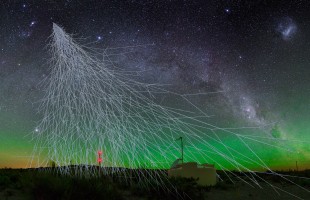First multimessenger observation of a neutron-star merger
“The Physics World 2017 Breakthrough of the Year goes to the international team of astronomers and astrophysicists that ushered in a new era of astronomy by making this first ever multimessenger observation involving gravitational waves. On 17 August 2017 the LIGO–Virgo gravitational-wave detectors and the Fermi Gamma-ray Space Telescope detected signals separated by just 2 seconds. They came from the merger of two neutron stars – an object now called GW170817. This was the first time that LIGO-Virgo scientists had seen a neutron star merger.” (From Physics World statement)
Within the LIGO-Virgo Collaboration, Nikhef makes important contributions to both the instrumentation and the data analysis. In particular, this concerns software for the detection and further analysis of gravitational waves from merging black holes and neutron stars, with the aim of testing the general theory of relativity, clarifying the internal structure of neutron stars, and the use of merging objects as a new way to mark distances in the universe, in order to understand the evolution of the universe on a large scale. Efforts are also being made to find continuous gravitational waves, for example from rapidly rotating neutron stars in binary star systems.
Nikhef is also part of the ANTARES and the Pierre Auger Observatory collaborations which (together with other neutrino observatories) have been looking for a neutrino signal from the observed neutron star merger event and could place an upper limit on the neutrino flux from this event. This provides complementary multi-messenger information.
Read more in the Nikhef press release of 16 October 2017 (scroll down for the English version)
Ultra-high-energy cosmic rays have extra-galactic origins
A runner-up was a discovery by another scientific collaboration that Nikhef is part of. It is the Pierre Auger Observatory collaboration for showing that ultra-high-energy cosmic rays come from outside the Milky Way.
“For decades, astrophysicists have believed that the sources of cosmic rays with energies greater than about 1 EeV (1018 eV) could be worked out from the arrival directions of these particles. This is unlike lower energy cosmic rays, which appear to come from all directions after being deflected by the Milky Way’s magnetic fields. Now, Pierre Auger’s 1600 Cherenkov particle detectors in Argentina have revealed that the arrival rate of ultra-high-energy cosmic rays is greater in one half of the sky. What is more, the excess lies away from the centre of the Milky Way – suggesting that the cosmic rays have extra-galactic origins.” (From Physics World statement)
Dutch physicists and astrophysicists have been involved in the research at Pierre Auger Observatorium since 2005. Spearhead in the Dutch research is the development of a detection technique, where radio receivers are used to detect cosmic rays.
About Physics World
Physics World is the membership magazine of the Institute of Physics, one of the largest physical societies in the world. It is an international monthly magazine covering all areas of physics, pure and applied, and is aimed at physicists in research, industry, physics outreach, and education worldwide. The magazine awards each year the Physics World Breakthrough of the Year. Read more about the 2017 Breakthroughs on the Physics World website
In 2016, the Physics World 2016 Breakthrough of the Year was awarded to the first direct detection of gravitational waves from two merging black holes (Nikhef press release). Read more about the 2016 Breakthroughs on the Physics World website
More information:
Science Communications Department Nikhef – Vanessa Mexner
Virgo / zwaartekrachtgolven – Nikhef-programmaleider Prof.dr. Frank Linde
Auger – Nikhef-programmaleider – Prof.dr. Sijbrand de Jong

